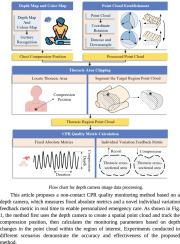基于深度相机的心肺复苏术患者胸部横截面积的非接触式实时监测
IF 4.9
2区 医学
Q1 ENGINEERING, BIOMEDICAL
引用次数: 0
摘要
心肺复苏(CPR)质量的实时监测对心脏骤停(CA)患者的复苏至关重要。然而,现有的监测设备测量的参数大多是固定的绝对指标,忽略了显著的个体差异反馈指标,如胸横截面积。为了解决这个问题,我们提出了一种基于深度相机的非接触式CPR质量监测方法,该方法可以实时测量按压深度、速率和患者胸部横截面积的变化。该方法首先利用深度相机创建空间点云并跟踪压缩位置,然后根据感兴趣区域内点云的深度变化计算监测参数。在不同场景下进行的实验验证了该方法的准确性和有效性。此外,对不同体型的心肺复苏模型的实验表明,相同的压缩水平会导致不同体型的压缩效果,这表明个性化的压缩策略可能会提高现实场景下的复苏成功率。本研究首次实现了心肺复苏过程中胸部横截面积的实时监测,为心肺复苏质量监测纳入了新的指标。本文章由计算机程序翻译,如有差异,请以英文原文为准。

Non-contact, real-time monitoring of patient thoracic cross-sectional area during CPR based on depth camera
Real-time monitoring of Cardiopulmonary Resuscitation (CPR) quality is crucial for the resuscitation of patients with cardiac arrest (CA). However, most of the parameters measured by existing monitoring devices are fixed absolute metrics, overlooking significant individual variation feedback metrics such as thoracic cross-sectional area. To address this, we propose a non-contact CPR quality monitoring method based on a depth camera, which measures compression depth, rate, and changes in the patient’s thoracic cross-sectional area in real time. The method first uses the depth camera to create a spatial point cloud and track the compression position, then calculates the monitoring parameters based on depth changes in the point cloud within the region of interest. Experiments conducted in different scenarios demonstrate the accuracy and effectiveness of the proposed method. Furthermore, experiments on CPR manikins of different body sizes reveal that the same level of compression results in different compression effects depending on the body size, suggesting that personalized compression strategies may improve the success rate of resuscitation in real-world scenarios. This study is the first to achieve real-time monitoring of thoracic cross-sectional area during CPR, incorporating a new indicator into CPR quality monitoring.
求助全文
通过发布文献求助,成功后即可免费获取论文全文。
去求助
来源期刊

Biomedical Signal Processing and Control
工程技术-工程:生物医学
CiteScore
9.80
自引率
13.70%
发文量
822
审稿时长
4 months
期刊介绍:
Biomedical Signal Processing and Control aims to provide a cross-disciplinary international forum for the interchange of information on research in the measurement and analysis of signals and images in clinical medicine and the biological sciences. Emphasis is placed on contributions dealing with the practical, applications-led research on the use of methods and devices in clinical diagnosis, patient monitoring and management.
Biomedical Signal Processing and Control reflects the main areas in which these methods are being used and developed at the interface of both engineering and clinical science. The scope of the journal is defined to include relevant review papers, technical notes, short communications and letters. Tutorial papers and special issues will also be published.
 求助内容:
求助内容: 应助结果提醒方式:
应助结果提醒方式:


